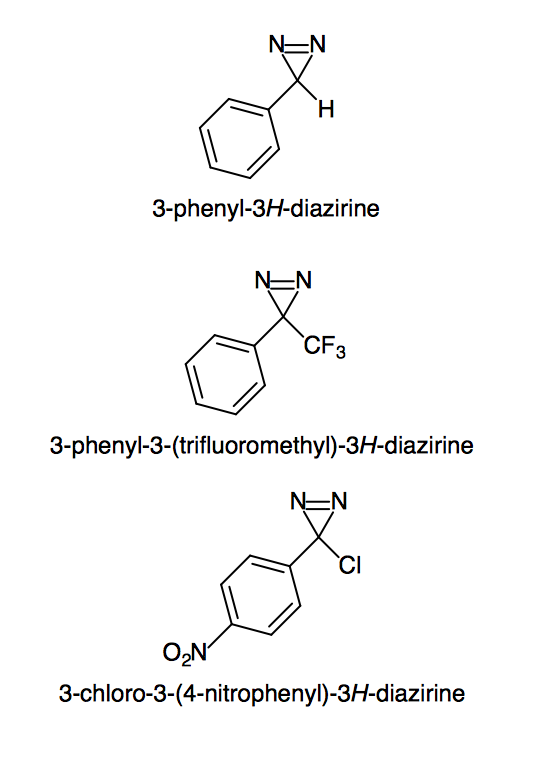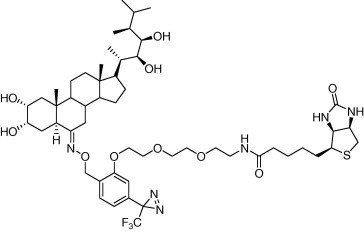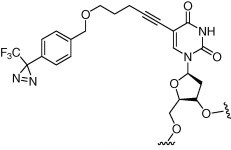Diazirine on:
[Wikipedia]
[Google]
[Amazon]
 Diazirines are a class of organic molecules consisting of a carbon bound to two nitrogen atoms, which are double-bonded to each other, forming a
Diazirines are a class of organic molecules consisting of a carbon bound to two nitrogen atoms, which are double-bonded to each other, forming a
 Diaziridines can be also produced directly by the reaction of ketones with ammonia in the presence of an aminating agent such as a
Diaziridines can be also produced directly by the reaction of ketones with ammonia in the presence of an aminating agent such as a 

 Carbenes produced from diazirines are quickly quenched by reaction with water molecules, and hence yields for photoreactive crosslinking assays are often low. Yet, as this feature minimizes unspecific labeling, it is actually an advantage of using diazirines.
Carbenes produced from diazirines are quickly quenched by reaction with water molecules, and hence yields for photoreactive crosslinking assays are often low. Yet, as this feature minimizes unspecific labeling, it is actually an advantage of using diazirines.
 * The discovery of novel non-CB1/CB2
* The discovery of novel non-CB1/CB2
 * The discovery that caprolactam-type gamma-secretase inhibitors target the SPP subunit of the
* The discovery that caprolactam-type gamma-secretase inhibitors target the SPP subunit of the
 * Incorporation of a diazirine moiety on a nucleoside base in a DNA polymer to investigate the mode of DNA repair by proteins.
* Incorporation of a diazirine moiety on a nucleoside base in a DNA polymer to investigate the mode of DNA repair by proteins. Diazirines have also been used to study protein lipid interactions, for example the interaction of various sphingolipids with proteins in vivo.
Diazirines have also been used to study protein lipid interactions, for example the interaction of various sphingolipids with proteins in vivo.
cyclopropene
Cyclopropene is an organic compound with the formula . It is the simplest cycloalkene. Because the ring is highly strained, cyclopropene is difficult to prepare and highly reactive. This colorless gas has been the subject for many fundamental st ...
-like ring, 3''H''-diazirene. They are isomer
In chemistry, isomers are molecules or polyatomic ions with identical molecular formulae – that is, same number of atoms of each element – but distinct arrangements of atoms in space. Isomerism is existence or possibility of isomers.
Iso ...
ic with diazo
The diazo group is an organic moiety consisting of two linked nitrogen atoms ( azo) at the terminal position. Overall charge neutral organic compounds containing the diazo group bound to a carbon atom are called diazo compounds or diazoalkanes ...
carbon groups, and like them can serve as precursors for carbene
In organic chemistry, a carbene is a molecule containing a neutral carbon atom with a valence of two and two unshared valence electrons. The general formula is or where the R represents substituents or hydrogen atoms.
The term "carbene" ma ...
s by loss of a molecule of dinitrogen
Nitrogen is the chemical element with the symbol N and atomic number 7. Nitrogen is a nonmetal and the lightest member of group 15 of the periodic table, often called the pnictogens. It is a common element in the universe, estimated at se ...
. For example, irradiation of diazirines with ultraviolet light
Ultraviolet (UV) is a form of electromagnetic radiation with wavelength from 10 nm (with a corresponding frequency around 30 PHz) to 400 nm (750 THz), shorter than that of visible light, but longer than X-rays. UV radiation i ...
leads to carbene insertion into various C-H, N-H, and O-H bonds. Hence, diazirines have grown in popularity as small photo-reactive crosslinking reagents. They are often used in photoaffinity labeling Photoaffinity labeling is a chemoproteomics technique used to attach "labels" to the active site of a large molecule, especially a protein. The "label" attaches to the molecule loosely and reversibly, and has an inactive site which can be converted ...
studies to observe a variety of interactions, including ligand-receptor, ligand-enzyme, protein-protein, and protein-nucleic acid interactions.
Synthesis
A number of methods exist in the literature for the preparation of diazirines, which begin from a variety of reagents.Synthesis from ketones
Generally, synthetic schemes that begin with ketones involve conversion of the ketone with the desired substituents todiaziridine
Diaziridines are heterocyclic compounds containing two nitrogen atoms in a three-membered ring. They can be considered as strained hydrazines. Unlike most amine types of structures, the nitrogen atoms of diaziridines are configurationally stable ...
s. These diaziridenes are then subsequently oxidized to form the desired diazirines.
Diaziridines can be prepared from ketones by oximation, followed by tosylation (or mesylation), and then finally by treatment with ammonia. Generally, oximation reactions are performed by reacting the ketone with hydroxylammonium chloride under heat in the presence of a base such as pyridine. Subsequent tosylation or mesylation of the alpha substituted oxygen with tosyl or mesyl chloride in the presence of base yields the tosyl or mesyl oxime. The final treatment of the tosyl or mesyl oxime with ammonia produces the diaziridine.
 Diaziridines can be also produced directly by the reaction of ketones with ammonia in the presence of an aminating agent such as a
Diaziridines can be also produced directly by the reaction of ketones with ammonia in the presence of an aminating agent such as a monochloramine
Monochloramine, often called chloramine, is the chemical compound with the formula NH2Cl. Together with dichloramine (NHCl2) and nitrogen trichloride (NCl3), it is one of the three chloramines of ammonia. It is a colorless liquid at its melting p ...
or hydroxyl amine O-sulfonic acid.
Diaziridines can be oxidized to diazirines by a number of methods. These include oxidation by chromium based reagents such as the Jones oxidation
The Jones oxidation is an organic reaction for the oxidation of primary and secondary alcohols to carboxylic acids and ketones, respectively. It is named after its discoverer, Sir Ewart Jones. The reaction was an early method for the oxidation o ...
, oxidation by iodine and triethylamine, oxidation by silver oxide, oxidation by oxalyl chloride, or even electrochemical oxidation on a platinum-titanium anode.

Synthesis by Graham reaction
Diazirines can be alternatively formed in a one-pot process using theGraham reaction In organic chemistry, the Graham reaction is an oxidation reaction that converts an amidine into a diazirine using a hypohalite reagent. The halide of the hypohalite oxidant, or another similar anion
An ion () is an atom or molecule with a n ...
, starting from amidine
Amidines are organic compounds with the functional group RC(NR)NR2, where the R groups can be the same or different. They are the imine derivatives of amides (RC(O)NR2). The simplest amidine is formamidine, HC(=NH)NH2.
Examples of amidines includ ...
s. This reaction yields a halogenated diazirine, whose halogen can be displaced by various nucleophilic reagents.
Chemistry
Upon irradiation with UV light, diazirines form reactivecarbene
In organic chemistry, a carbene is a molecule containing a neutral carbon atom with a valence of two and two unshared valence electrons. The general formula is or where the R represents substituents or hydrogen atoms.
The term "carbene" ma ...
species. The carbene may exist in the singlet form, in which the two free electrons occupy the same orbital, or the triplet form, with two unpaired electrons in different orbitals.
Triplet vs singlet carbene products
The substituents on the diazirine affect which carbene species is generated upon irradiation and subsequent photolytic cleavage. Diazirine substituents that are electron donating in nature can donate electron density to the empty p-orbital of the carbene that will be formed, and hence can stabilize the singlet state. For example, phenyldiazirine produces phenylcarbene in the singlet carbene state whereas p-nitrophenylchlorodiazirine or trifluorophenyldiazirine produce the respective triplet carbene products. Electron donating substituents can also encourage photoisomerization to the linear diazo compound 0/sup>, rather than the singlet carbene, and hence these compounds are unfavorable for use in biological assays. On the other hand, trifluoroaryldiazirines in particular show favorable stability and photolytic qualities and are most commonly used in biological applications. Carbenes produced from diazirines are quickly quenched by reaction with water molecules, and hence yields for photoreactive crosslinking assays are often low. Yet, as this feature minimizes unspecific labeling, it is actually an advantage of using diazirines.
Carbenes produced from diazirines are quickly quenched by reaction with water molecules, and hence yields for photoreactive crosslinking assays are often low. Yet, as this feature minimizes unspecific labeling, it is actually an advantage of using diazirines.
Use in photoreactive crosslinking
Diazirines are often used as photoreactive crosslinking reagents, as the reactive carbenes they form upon irradiation with UV light can insert into C-H, N-H, and O-H bonds. This results in proximity dependent labeling of other species with the diazirine containing compound. Diazirines are often preferred to other photoreactive crosslinking reagents due to their smaller size, longer irradiation wavelength, short period of irradiation required, and stability in the presence of various nucleophiles, and in both acidic and basic conditions.Benzophenone
Benzophenone is the organic compound with the formula (C6H5)2CO, generally abbreviated Ph2CO. It is a white solid that is soluble in organic solvents. Benzophenone is a widely used building block in organic chemistry, being the parent diarylket ...
s, which form reactive triplet carbonyl species upon irradiation, often require long periods of irradiation which can result in non-specific labeling, and moreover are often inert to various polar solvents. Aryl azides require a low wavelength of irradiation, which can damage the biological macromolecules under investigation.
Examples in receptor labeling studies
Diazirines are widely used in receptor labeling studies. This is because diazirine-containing analogs of various ligands can be synthesized and incubated with their respective receptors, and then subsequently exposed to light to produce reactive carbenes. The carbene will covalently bond to residues in the binding site of the receptor. The carbene compound may include a bioorthogonal tag or handle by which the protein of interest can be isolated. The protein can then be digested and sequenced by mass spectrometry in order to identify which residues the carbene containing ligand is bound to, and hence the identity of the binding site in the receptor. Examples of diazirines used in receptor labeling studies include: * The discovery of abrassinosteroid
Brassinosteroids (BRs or less commonly BS) are a class of polyhydroxysteroids that have been recognized as a sixth class of
plant hormones and may have utility as an anticancer drug for endocrine-responsive cancers to induce apoptosis and inhibi ...
receptor for brassinosteroid plant hormones by Kinoshita et al. Researchers used a plant hormone analog with a diazirine crosslinking moiety and a biotin tag for isolation to identity the new receptor. This study led to a number of similar studies conducted with regards to other plant hormones.
 * The discovery of novel non-CB1/CB2
* The discovery of novel non-CB1/CB2 cannabinoid receptor
Cannabinoid receptors, located throughout the body, are part of the endocannabinoid system a class of cell membrane receptors in the G protein-coupled receptor superfamily. As is typical of G protein-coupled receptors, the cannabinoid recepto ...
s using anandamide
Anandamide (ANA), also known as ''N''-arachidonoylethanolamine (AEA), is a fatty acid neurotransmitter. Anandamide was the first endocannabinoid to be discovered: it participates in the body's endocannabinoid system by binding to cannabinoid rec ...
analog probes containing a diazirine group by Balas et al.
* The binding cavity of the hypnotic
Hypnotic (from Greek ''Hypnos'', sleep), or soporific drugs, commonly known as sleeping pills, are a class of (and umbrella term for) psychoactive drugs whose primary function is to induce sleep (or surgical anesthesiaWhen used in anesthesia ...
agent propofol
Propofol, marketed as Diprivan, among other names, is a short-acting medication that results in a decreased level of consciousness and a lack of memory for events. Its uses include the starting and maintenance of general anesthesia, sedation f ...
in the GABAA receptor using a diazirine containing propofol analog.
Examples in enzyme-substrate studies
In a manner analogous to receptor labeling, diazirine containing compounds that are analogs of natural substrates have also been used to identify binding pockets of enzymes. Examples include: * The synthesis of a diazirine containing analog ofetoposide
Etoposide, sold under the brand name Vepesid among others, is a chemotherapy medication used for the treatments of a number of types of cancer including testicular cancer, lung cancer, lymphoma, leukemia, neuroblastoma, and ovarian cancer. It is ...
, a widely used cancer drug targeting topoisomerase II
Type II topoisomerases are topoisomerases that cut both strands of the DNA helix simultaneously in order to manage DNA tangles and supercoils. They use the hydrolysis of ATP, unlike Type I topoisomerase. In this process, these enzymes change the ...
, which holds promise for the identification of the etoposide binding site. * The discovery that caprolactam-type gamma-secretase inhibitors target the SPP subunit of the
* The discovery that caprolactam-type gamma-secretase inhibitors target the SPP subunit of the gamma-secretase
Gamma secretase is a multi-subunit protease complex, itself an integral membrane protein, that cleaves single-pass transmembrane proteins at residues within the transmembrane domain. Proteases of this type are known as intramembrane proteases. Th ...
, which has been implicated in Alzheimer's disease.
Examples in nucleic acid studies
Diazirines have been used in photoaffinity labeling experiments involving nucleic acids as well. Examples include: * Incorporation of a diazirine moiety on a nucleoside sugar in a DNA polymer to investigate interactions between the minor groove of DNA and DNA polymerases. * Incorporation of a diazirine moiety on a nucleoside base in a DNA polymer to investigate the mode of DNA repair by proteins.
* Incorporation of a diazirine moiety on a nucleoside base in a DNA polymer to investigate the mode of DNA repair by proteins. Diazirines have also been used to study protein lipid interactions, for example the interaction of various sphingolipids with proteins in vivo.
Diazirines have also been used to study protein lipid interactions, for example the interaction of various sphingolipids with proteins in vivo.
References
{{reflist30. S. M. Korneev: ''Valence Isomerization between Diazo Compounds and Diazirines''. In: ''Eur. J. Org. Chem.'' (2011), Band 31, S. 6153–6175, doi:10.1002/ejoc.201100224 Nitrogen heterocycles Photochemistry